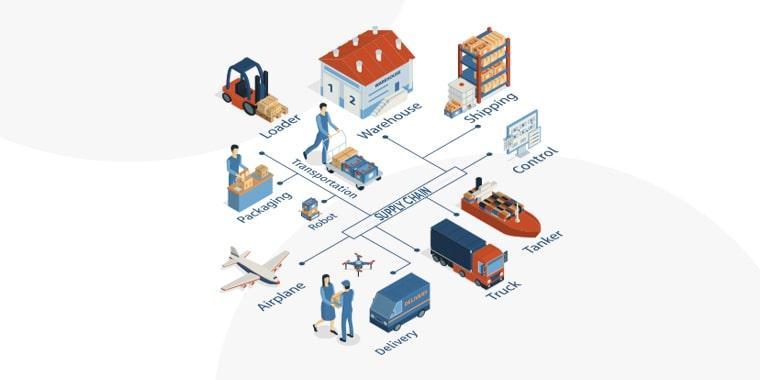Content Attributes
Re-defining Supply Chain Management with Robust ERP Solution
A lot has been talked about and still been talked about the latest trends and innovations going around the market to inspire manufacturers to do something new and make way for their increased brand awareness. Manufacturers today seem to have gained the right intelligence on how to convince customers and give a special effect to their manufactured products.
By doing this they are not just winning the hearts of the customers but also beating the cutting-edge competition with their right skill set and hard work. Most of the manufacturing businesses today irrespective of their size are automated and have set next-level quality standards for their finished items.
What has brought this change to the industry?

There are several factors that have contributed to the change in the industry and the increasing adoption of ERP solutions in supply chain management. Some of these factors include:
- Increased Competition: As competition continues to intensify, companies are looking for ways to gain a competitive advantage. By streamlining supply chain processes and improving visibility, companies can improve their efficiency and reduce costs, allowing them to offer competitive prices and better service.
- Changing Customer Expectations: Customers today expect faster delivery times, accurate order fulfillment, and transparent communication throughout the supply chain process. Companies that are able to meet these expectations are more likely to succeed in the market.
- Technological Advancements: The advancements in technology, particularly in areas such as cloud computing, data analytics, and mobile devices, have made it easier and more affordable for companies to implement ERP solutions in supply chain management.
- Globalization: As supply chains become more complex and global, companies need a way to manage and monitor their operations across multiple locations and time zones. ERP solutions provide a centralized platform for managing all aspects of the supply chain, regardless of location.
- Regulatory Requirements: With increasing regulatory requirements and the need for greater transparency in supply chain operations, companies are turning to ERP solutions to help them comply with regulations and monitor their operations more closely.
Overall, the combination of these factors has led to a growing recognition of the benefits of ERP solutions in supply chain management and the increasing adoption of these solutions by companies across industries.
Restructuring Supply Management
Restructuring supply management with SAP Business One is a strategic process that involves optimizing supply chain operations using the features and capabilities of the software. Here are some steps that can be followed to restructure supply management with SAP Business One:
Analyze the Current Supply Chain Process:
The first step is to analyze the current supply chain process and identify areas that need improvement. This involves reviewing supply chain data, analyzing supply chain workflows, and identifying bottlenecks and inefficiencies.
Set Goals and Objectives:
Based on the analysis, companies should set specific goals and objectives for the restructuring process. This can include improving lead times, reducing costs, increasing efficiency, and improving overall supply chain performance.
Develop a Plan:
Once the goals and objectives are set, companies should develop a comprehensive plan that outlines the specific steps and actions needed to achieve these goals. This plan should include timelines, resource requirements, and key performance indicators (KPIs) to measure progress.
Implement SAP Business One:
SAP Business One can be used to optimize supply chain operations. This includes automating purchase orders, tracking deliveries, managing payments, and forecasting demand. By implementing a Robust ERP Solution, companies can improve supply chain visibility, reduce errors, and improve accuracy.
Redesign Workflows:
In addition to implementing SAP Business One, companies may need to redesign workflows and processes to optimize performance. This can involve reorganizing supply chain teams, changing communication protocols, and creating new performance metrics.
Monitor and Measure Progress:
Once the restructuring process is underway, it’s important to monitor progress and measure results against the established KPIs. This will help companies identify areas that still need improvement and make adjustments to the plan as needed.
Overall, restructuring supply management with Robust ERP Solution can help companies optimize supply chain operations, reduce costs, and improve efficiency. By automating processes, improving visibility, and making data-driven decisions, companies can stay competitive and meet the demands of their customers.
Let’s understand what all changes can be made in the supply chain with the adoption of ERP.
Benefits of ERP in Supply Chain Management
In today’s global economy, supply chain management (SCM) is a critical component of business success. Companies must be able to efficiently manage the flow of goods and services from suppliers to customers while keeping costs under control. One tool that can help companies achieve this goal is Enterprise Resource Planning (ERP) software. In this blog, we will explore the benefits of ERP in supply chain management.
Streamlined Processes
- ERP software can help streamline the entire supply chain process, from procurement to delivery, by providing a centralized platform for managing all aspects of the supply chain.
- By automating routine tasks, such as purchase order generation and inventory management, ERP can reduce the likelihood of errors and improve the accuracy of data.
Improved Collaboration
- ERP software can improve collaboration between departments and stakeholders by providing a common platform for sharing information and data.
- For example, sales and marketing teams can access real-time inventory levels to inform their sales strategies, while production teams can use the same data to plan production schedules.
Enhanced Visibility
- ERP software can provide enhanced visibility into supply chain operations, allowing companies to identify and resolve bottlenecks and inefficiencies.
- Real-time data on inventory levels, production schedules, and delivery times can help companies make informed decisions about purchasing and production.
Cost Reduction
- By automating routine tasks, reducing errors, and improving efficiency, ERP software can help companies reduce costs across the entire supply chain.
- With better inventory management and improved visibility into demand, companies can reduce inventory carrying costs while minimizing stockouts and excess inventory.
Improved Customer Service
- ERP software can help companies improve customer service by providing real-time data on inventory levels, production schedules, and delivery times.
- By fulfilling customer orders quickly and accurately, companies can improve customer satisfaction and loyalty.
Benefits of ERP in Supply Chain Management
| Benefit | Description |
|---|---|
| Streamlined Processes | Automates routine tasks, reduces errors, improves data accuracy |
| Improved Collaboration | Enhances communication and data sharing between departments and stakeholders |
| Enhanced Visibility | Provides real-time data on inventory levels, production schedules, and delivery times |
| Cost Reduction | Reduces costs across the supply chain by improving efficiency and inventory management |
| Improved Customer Service | Provides real-time data on inventory levels and delivery times, improving order fulfillment and customer satisfaction |
In conclusion, all we can say is that suppliers are the bridge between manufacturers and consumers and to avoid any miscommunication of commodities, it’s high time now to make supply chain management an advanced process.
Also Read:
- How to Prep a Room for Painting and Interior Painting
- How to choose the right ERP Software?
- Unveil the Benefits of Cloud ERP Software
- How Do Enterprise Resource Planning Boost Business Performance & Profits
- Implement an ERP for your Business: Should you Rely on a Consultant?



